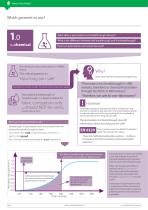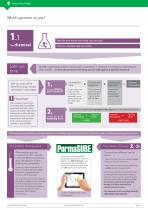
Catalog excerpts

LakelamfThe Guide to Chemical Suit Selection A guide to the selection of Lakeland manufactured clothing for protection against hazardous chemicals.
Open the catalog to page 1
Protect Your People Lakeland Chemical Protective Clothing Chemical Suit Selection Guide Lakeland delivers the best, most innovative Protective Clothing products and fabric choices in the world. This guide provides detailed descriptions Broadest range of products and fabrics and technical information on the range of The wide choice of fabrics and styles offered means users can target selected protection more specifically to their application - which means better protection, greater comfort and lower cost. Lakeland offers the right tool for the job… because if all you have is a hammer…...
Open the catalog to page 2
Protect Your People Is meeting a standard enough? But does merely ensuring PPE is certified ensure you are protected? Many users now rely on CE standards to ensure that the PPE they choose will provide protection. There are three reasons why just meeting a standard is not enough Use the link to download our e-books on why CE certification does not make a product safe to use. CE standards represent MINIMUM performance levels. For example, in chemical protection, Type 3,4 5 and 6 testing allows for SOME penetration of a chemical inside the suit below defined levels. Most users assume passing...
Open the catalog to page 3
Protect Your People What does a permeation test breakthrough tell you? How can permeation test results be used? What is the difference between test breakthrough and first breakthrough? The chemical is the primary factor in FABRIC choice. Some users make the incorrect assumption that: ‘How long am I safe’ Permeation test results are often incorrectly used to answer this question. “Permeation test breakthrough is >480 minutes, therefore no chemical has broken through the fabric in 480 minutes” . ‘Normalised breakthrough’ or ‘breakthrough’ is a figure suitable for “Therefore I am safe for over...
Open the catalog to page 4
Which garment to use? Safe-use time Breakthrough should only be used for fabric comparison - to indicate if one fabric is a better barrier than another... so how do you know how long you are safe against a specific chemical? Safe-use time can be identified using a simple calculation in two stages: Permeation Rate H However Such analysis should only be undertaken by qualified personnel and wide safety margins should be allowed as information is often limited, permeation times vary with temperature and exposure limits may be uncertain, variable or not available. 2. Compare with chemical...
Open the catalog to page 5
Guide to Garment Selection - Permeation Test Comparison Tables ChemMax® 1 vs Brands A and B In some cases the EN Class 6 result for Lakeland fabrics has been assumed from the equivalent US permeation test ASTM F739. This is the same test but uses a permeation rate ten times LOWER than the European version. Thus where the result in the US test is >480m it is reasonable to assume that a test measuring to a HIGHER rate would be at least the same. NT = Not Tested NA = Not Available Imm = Immediate 1.2 Permeation Test Comparison Tables Permeation testing (to EN 6529) is required by the Type 3 &...
Open the catalog to page 6
Guide to Garment Selection - Permeation Test Comparison Tables ChemMax® 2, 3 and 4 vs Brands C and D www.lakeland.com/europe Page 7 sales-europe@lakeland.com
Open the catalog to page 7
Guide to Garment Selection - Permeation Test Comparison Tables ChemMax® 4 & Interceptor® vs Brands E, F and G Table 3: ChemMax® 4 and Interceptor® vs Brands E, F and G ChemMax® 4 - achieves an equal or better result for 89% of comparable chemicals. Interceptor® - achieves an equal or better result for 94% of comparable chemicals. Permeation testing is for comparison purposes only and should not be used to indicate safe-use times. A test breakthrough of >480m does NOT mean you are safe for 480 minutes or that no chemical has broken through the fabric in that time. PermaSURE® is an on-line...
Open the catalog to page 8
Protect Your People Guide to Garment Selection PermaSURE® : Real Safe-Use Times for ChemMax® 3, 4 and Interceptor® PermaSURE® : real safe-use times for ChemMax® 3, 4 and Interceptor® Permeation test breakthrough is NOT when the chemical first breaks through the fabric and provides NO information on how long you are safe. (see pages 4 & 5) So how do you know how long you are safe? To find a safe-use time, users need to calculate a volume permeated using permeation rate, exposed area and exposure time:- Permeation Area Time Volume X = Rate X Exposed Exposed Permeated This can then be compared...
Open the catalog to page 9
• Light spray • Liquid spray • Jet spray • Vapours/gases 2.0 The task/ hazard type?The task may suggest a choice of fabric and garment design. CE Types are a good guide to the different types of chemical contact and a clear indication of garment choice. Physical factors such as strenuous work? Light Spray TYPE 6 Hazardous Dust TYPE 5 Liquid Spray TYPE 4 The physical demands of a task, such as climbing ladders, crawling or working in confined spaces, especially if the chemical is highly toxic, might suggest higher strength fabric or a specific design, even though permeation analysis and/or...
Open the catalog to page 10
Protect Your People Garment Selection Guide ….. Which Hazard Spray Type? ? Why define the difference between Type 3 and 4 protection? hazard /spray type? The EN 14605 standard defines two different levels of liquid spray protection: Type 3 & 4. Most garments on the market are Type 3 and 4. Each type is tested with a distinct finished garment spray test. (see panel below) By identifying that your application is Type 4 only (rather than Type 3) allows more options for garment design choice and enables a greater level of comfort. EN 14065 - Type 4 : “liquid” sprays • Strong, directional jets...
Open the catalog to page 11
Which garment to use? 3.0 Physical/environmental factors? What factors in the environment affect garment choice? Can guide both fabric (eg. stronger options?) and design (eg. knee-pads required?) choices. These can be assessed in three groups. 2. The Environment 3. Other issues Other PPE required? Other PPE required, eg. gloves, SCBA, boots, fall-arrest equipment). Consider the overall effectiveness of the ensemble. Will one impair the function of another? Do they fit together appropriately? For a tested liquid-tight seal between gloves and suit sleeves see the Push-Lock® glove connection...
Open the catalog to page 12All Lakeland catalogs and technical brochures
-
CE MicroMax NS PDS EN
2 Pages
-
CE Pyrolon XT PDS
2 Pages
-
CE SafeGard GP PDS
2 Pages
-
CE Type 56 Select Guide
13 Pages
-
Arc® X
2 Pages
-
PermaSURE
2 Pages
-
ChemMax® Encapsulating Suits
2 Pages
-
ALM 300
2 Pages
-
ALM 300/500
2 Pages
-
Arc® 43
2 Pages
-
Lakeland ALM®
4 Pages















